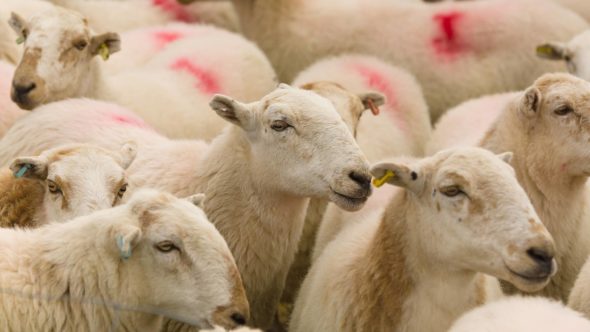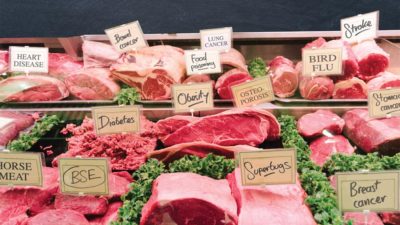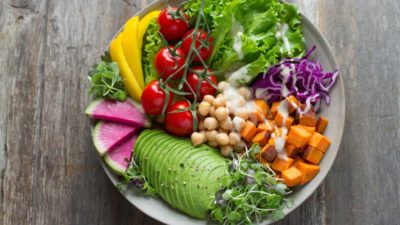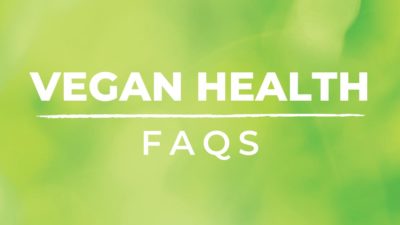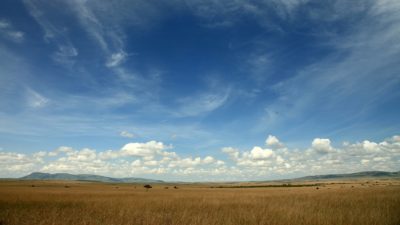How Sheep and Lambs Are Farmed and Killed
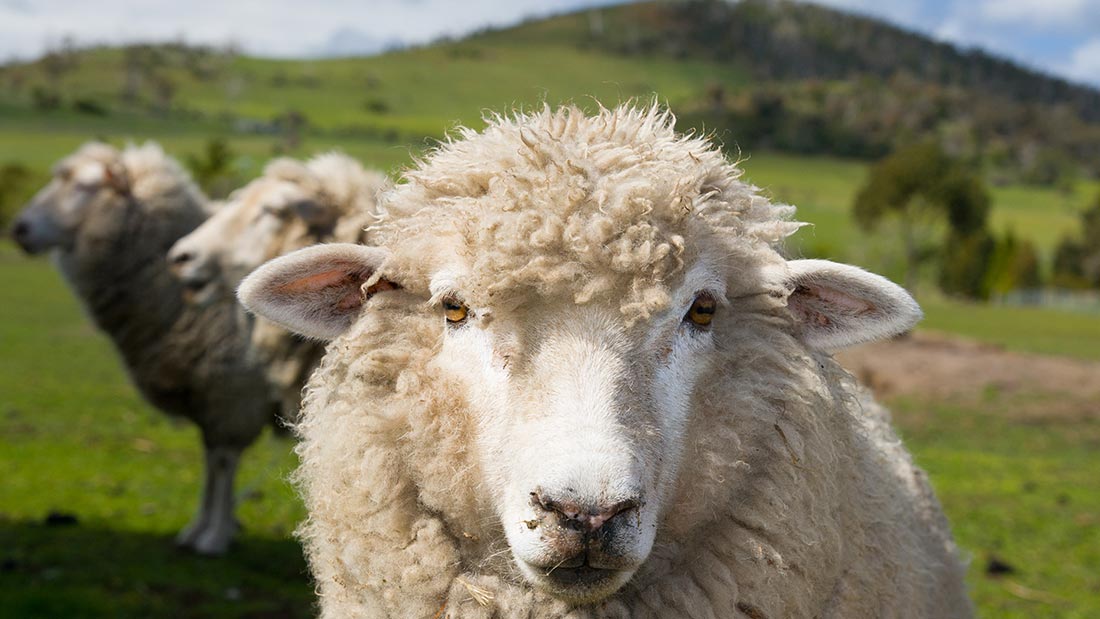
- Sheep form friendships within their flock and will stay closer to those with shared experiences 1 Keshavarzi H et al. 2023. Shared stressful experiences affect social proximity in Merino sheep. Biology Letters, 8 February. Available at https://royalsocietypublishing.org/doi/10.1098/rsbl.2022.0396 [Accessed 20 March 2025]
- Sheep have excellent facial recognition abilities – they can remember up to 50 individual faces (both sheep and human), as well as distinguish between different facial expressions 2 Kendrick KM, da Costa AP, Leigh AE et al. 2001. Sheep don’t forget a face. Nature. 414 (6860) 165-6.
- Sheep experience complex emotional states which can be studied by observing their body language, such as the position of their ears and facial expressions 3 Boissy A et al. 2011. Cognitive sciences to relate ear postures to emotions in sheep. Animal Welfare, 20 (1)47-56. Available at https://www.cambridge.org/core/journals/animal-welfare/article/abs/cognitive-sciences-to-relate-ear-postures-to-emotions-in-sheep/92D5B366151975AC4249A263562C2421 [Accessed 20 March 2025]
- Sheep self-medicate when they feel unwell and will eat certain plants that help relieve their symptoms when something has made them ill 4 Villalba J, Provenza F and Shaw R. 2006. Sheep self-medicate when challenged with illness-inducing foods. Animal Behaviour. 71, 5, 1131-1139.
- Sheep have similar levels of intelligence to pigs – one of the smartest animals on the planet 5Marino L and Merskin D. 2019. Animal sentience, intelligence, complexity, and individuality in sheep. Animal Sentience. 25, 1.
- Ewes are caring mothers who use grooming and vocalisations to form strong bonds with their offspring 6 Schiller K and Horback K, 2024. Perinatal behavioural patterns during and after human-animal interactions in rangeland breeding ewes. Frontiers in Animal Science. Available at: https://www.frontiersin.org/journals/animal-science/articles/10.3389/fanim.2024.1366211/full [Accessed 20 March 2025]
Far from the stereotype of being mindless and stupid, sheep have been shown, through multiple studies, to be intelligent and emotionally complex and to have excellent memories and individual personalities. 1Marino L and Merskin D, 2019. Animal sentience, intelligence, complexity, and individuality in sheep. Animal Sentience. Available at https://animalstudiesrepository.org/cgi/viewcontent.cgi?article=1374&context=animsent&fbclid=IwAR1z4YE04Ps9WST0M0DNj8QvURB1ETobJdIHKI06GS4TygR9yB7ukNdHCfA [Accessed 26 March 2020]. Given recent studies revealing just how intelligent they are, sheep have been given a bit of a raw deal for generations.
Keith Kendrick, Professor of Neurobiology at the University of Electronic Science and Technology of China, notes: “Sheep may be capable of using the same system [as humans] to remember and respond emotionally to individuals in their absence,” and goes on to acknowledge similarities between how sheep’s minds and humans’ minds work. 2 Kendrick K, da Costa A, Leigh A et al, 2001. Sheep don’t forget a face. Nature. 414, 165-166, November. Available at https://www.nature.com/articles/35102669 [Accessed 3 April 2020]. What he means is that sheep can remember 50 other individual sheep’s faces for at least two years and have a better memory for faces than some people!
Sheep can learn how to navigate out of complex mazes, spurred on by the sight of their friends at the exit who help them to find it more quickly. This suggests they have strong emotional reactions to the presence of familiar faces.
Sheep aren’t just a bit more intelligent than we give them credit for. “Sheep show competence in many cognitive domains, including memory and discrimination capacity,” says Lori Marino, a neuroscientist who studies animal intelligence. “They excel especially in executive function and face perception, performing on par with some primates.” 1 Marino L and Merskin D, 2019. Animal sentience, intelligence, complexity, and individuality in sheep. Animal Sentience. Available at https://animalstudiesrepository.org/cgi/viewcontent.cgi?article=1374&context=animsent&fbclid=IwAR1z4YE04Ps9WST0M0DNj8QvURB1ETobJdIHKI06GS4TygR9yB7ukNdHCfA [Accessed 26 March 2020].
Sheep’s brains have similarities to ours, particularly the basal ganglia – a part of the brain that controls important functions such as decision-making, learning and habit formation. 3Murray S et al. 2019. Chemical neuroanatomy of the substantia nigra in the ovine brain. Journal of Chemical Neuroanatomy. 97, 43-56. It follows that sheep probably make decisions and learn in a similar way to us. They also have complex folds in their brain that are seen in just a few animals, including primates, which is another indicator that sheep are far more intelligent than they’ve been given credit for. 4 University of Cambridge. 2015. Counting on sheep. Available at: https://www.cam.ac.uk/research/features/counting-on-sheep [Accessed 3 April 2020].
As well as being brainier than we thought, sheep display a complex array of emotions, including optimism and pessimism. 5Marino L and Merskin D. 2019. Thinking sheep: a review of cognition, emotion, and social complexity in domestic sheep. Available at https://www.kimmela.org/wp-content/uploads/2020/09/TSP_SHEEP_WhitePaper.pdf [Accessed 1 April 2025] They have distinct individual personalities which inform their behaviour and form long-term friendships within their flocks. 5Marino L and Merskin D. 2019. Thinking sheep: a review of cognition, emotion, and social complexity in domestic sheep. Available at https://www.kimmela.org/wp-content/uploads/2020/09/TSP_SHEEP_WhitePaper.pdf [Accessed 1 April 2025] They have also been shown to feel sadness and like humans, they grieve over the loss of a loved one. When you look at sheep as the intelligent animals they obviously are, it somehow makes their treatment as livestock even more horrific. 5Marino L and Merskin D. 2019. Thinking sheep: a review of cognition, emotion, and social complexity in domestic sheep. Available at https://www.kimmela.org/wp-content/uploads/2020/09/TSP_SHEEP_WhitePaper.pdf [Accessed 1 April 2025]
Where Do Sheep Come From?
Of all the sheep species, the modern domesticated one is by far the most common, with a population of over one billion worldwide. They are most likely descended from the wild mouflon between 11,000 and 9,000 BC. There are multiple species of sheep and hundreds (if not thousands) of distinct breeds, all forming part of the Bovidae family of cloven-hoof ruminants. If humans didn’t farm sheep, there would still be a huge variety of species and subspecies around the world, from Central Europe to the Middle East and Asia to North America. Over the 10,000 years of domestication, modern sheep have become very different to wild sheep.
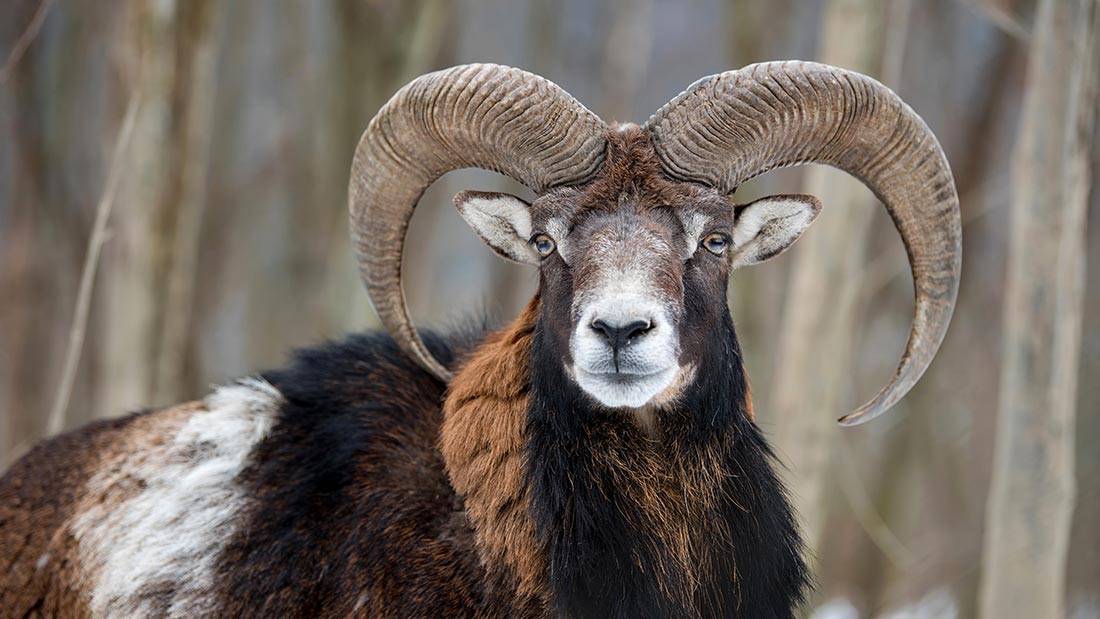
Wild Sheep
Wild sheep still exist around the world and give us a good idea of the ancestry of domesticated sheep. They are ruminants like cows, chewing, swallowing and then regurgitating the cud in order to digest their food. They tend to live in hilly and mountainous habitats and flee uphill when threatened by predators. Renowned for their meekness, sheep do occasionally fight back against predators and Dall sheep can even knock wolves off cliffs with their horns.
Sheep are social animals but tend to stick with their own gender outside the mating season, which is known as the rut. Male bachelor flocks vary in size, from as little as five to 50 rams. Females live in nursery flocks, ranging from five to 100 animals, including young.
Wild sheep are known for their impressive horns, particularly the aptly named Bighorn sheep, native to North America, whose sturdy horns curve back behind their ears and can weigh up to 14 kilograms. Sheep use their horns to establish their hierarchy within the flock. Rams are particularly agile and when running, some species can reach speeds of up to 20 miles per hour, which is particularly spectacular when two males run at each other and clash head-on in order to establish dominance. 1 National Geographic Animals. 2018. How do big horn sheep butt heads? [online video] Available at: https://www.youtube.com/watch?v=Miq8bW6tNEE [Accessed 26 March 2025] This can go on for hours and ends only once one of them submits. Rams have to show great endurance and strength to reach the top of the hierarchy.
Lambs typically walk within half an hour after birth and would naturally suckle from their mothers for the first four to six months of life. 2Nowak R et al. 2021. Neonatal suckling, Oxytocin, and early infant attachment to the mother. Frontiers in Endocrinology. 11, 612651. Depending on the breed and several environmental factors, wild sheep become sexually mature anywhere between one-and-a-half and five years old.
Natural Diet
Wild sheep are naturally herbivorous and enjoy a wide variety of plants, including seeds, short roughage and wildflowers. Again, contrary to popular belief, sheep are not that interested in grass or clover, especially when more interesting and nutritious food is available. 3 Raising Sheep. What do sheep eat? Available at: http://www.raisingsheep.net/what-do-sheep-eat.html [Accessed 26 March 2025]
Life Expectancy
A sheep’s natural lifespan varies widely, depending on the breed. The record for the oldest animal is over 28 years 4Guinness World Records. Oldest sheep ever. Available at: https://www.guinnessworldrecords.com/world-records/70761-oldest-sheep-ever [Accessed 26 March 2025] but domestic British sheep would typically live about 10 to 12 years (if not sent to slaughter earlier), similar to many breeds of dogs.
Predators
In their natural habitat from North America to the Middle East, wild sheep have a variety of predators, including coyotes, mountain lions and bears, while birds of prey such as eagles may take lambs.
Wild Sheep and Modern Sheep
Modern, domesticated sheep differ from wild breeds in several ways. For example, wild sheep shed their hair naturally while selective breeding by humans over many generations has produced sheep whose wool needs to be sheared to avoid overheating, mobility issues, and parasites, leading to health problems and even death.
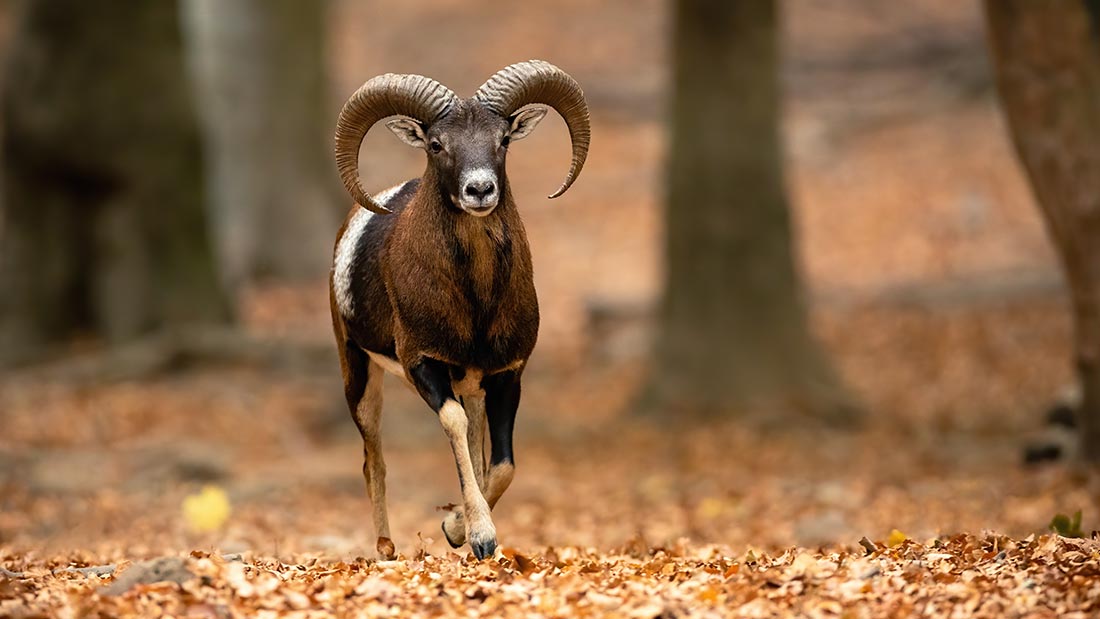
Domesticated sheep have also been selectively bred to produce twins and triplets rather than the single lamb that is usual in the wild. With just one offspring, a mother can give more attention and offer better protection than with multiple births, which result in high mortality rates. While lambs would naturally suckle for at least four months, in modern farming they are weaned quickly and then fattened for slaughter within the first few months of life. 5 Phillips K. 2019. Advice for weaning lambs to help reduce stress. Farmers Weekly, 17 July. Available at: https://www.fwi.co.uk/livestock/advice-weaning-lambs-help-reduce-stress [Accessed 26 March 2025].
Sheep farming is seen as probably the most natural of all animal agriculture because the majority of animals are still farmed outdoors. It hides the fact that exploitation and cruelty are still rife.
How many Sheep are Farmed and Killed in the UK?
In 2024, 14.4 million of the UK’s 31 million sheep were slaughtered and the value of their meat was estimated to be around £1.6 billion. 1Defra. 2024. Agriculture in the UK, 2023. Available at: https://www.gov.uk/government/statistics/agriculture-in-the-united-kingdom-2023/chapter-8-livestock [Accessed 24 March 2025]
Lambs
Ewes and their lambs form strong bonds at birth and are quickly able to recognise one another from their bleats. 2Freitas-de-Melo A et al. 2021. Ewe-lamb bond of experienced and inexperienced mothers undernourished during gestation. Scientific Reports. 11 (1) 4634. Lambs can walk within minutes of being born and would naturally suckle and stay with their mothers for four to six months. Farmers sometimes forcibly wean lambs at just eight weeks old, keeping them out of sight and earshot of their mothers and putting them to grass so they gain weight more quickly. 3 National Sheep Association. 2025. The sheep farming year. Available at: https://nationalsheep.org.uk/for-the-public/culture/the-sheep-farming-year/ [Accessed 24 March 2025]
Castration
It is standard practice to mutilate male lambs by using a tight rubber ring, a clamp or surgery to castrate them, usually at less than one week old. Even when anaesthetic is used, castration still causes chronic and acute pain. 4 Higgins H. 2022. Does local anaesthetic reduce pain in rubber ring castration of neonatal lambs? Veterinary Evidence. Available at: https://veterinaryevidence.org/index.php/ve/article/view/658 [Accessed 25 March 2025] Lambs are castrated to improve the taste of their meat, render them more docile for handling and reduce aggression between ‘intact’ males.
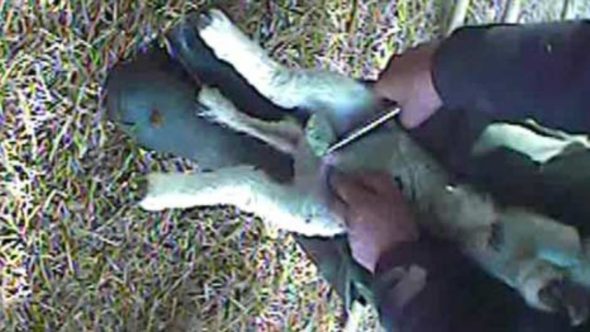
Tail Docking
Very young lambs are subjected to a second painful mutilation by having their tails docked – a hot iron, tight rubber ring or knife is used to remove most of their tail. 5 Balsom A. 2020. Tail docking lambs: advice, legislation and methods compared. Farmers Weekly, 13 January. Available at https://www.fwi.co.uk/livestock/husbandry/tail-docking-lambs-advice-legislation-and-methods-compared [Accessed 25 March 2025]. Rubber rings for both castration and tail docking work by cutting off the blood supply so that the appendage shrinks and shrivels before dropping off. Although farmers claim that both are done for the sheep’s benefit, wild sheep have no need of either mutilation. The practices are only necessary because of what humans have done to the animals and to make farming them easier. 6 RSPCA. 2024. Sheep Welfare. Available at: https://www.rspca.org.uk/adviceandwelfare/farm/sheep [Accessed 25 March 2025]
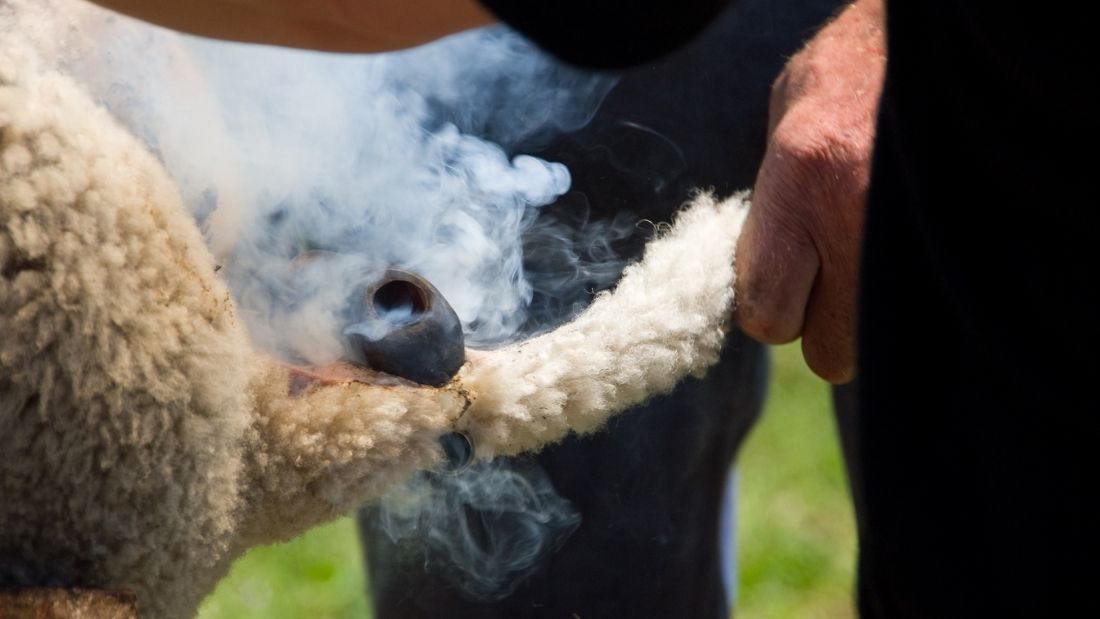
Mortality Rates
Ewes have been manipulated through selective breeding into giving birth to twins and even triplets, quadruplets and very occasionally quintuplets, all unnatural in wild sheep. This is partly why lamb mortality is high, at over 10 per cent of all births in the UK. 7 AHDB. 2020. Factors affecting neonatal survival on beef and sheep farms. Available at: https://ahdb.org.uk/development-of-an-integrated-neonatal-survival-and-sustainable-antibiotic-plan [Accessed 25 March 2025] With around 15 million lambs born each year, over 1.5 million of them die from disease and exposure. 8AHDB 2024. Defra’s June survey shows UK beef and sheep populations at historic lows. Available at: https://ahdb.org.uk/news/beef-lamb-market-update-defra-s-june-survey-shows-uk-beef-and-sheep-populations-at-historic-lows [Accessed 25 March 2025]
The mortality rate is in part so high because farmers want to cash in on the spring lamb market when lamb carcasses yield higher returns, leading to induced pregnancies taking place earlier and earlier in the year. 9AHDB. 2020. GB Deadweight sheep prices.’ AHDB. Updated Weekly. Available at https://ahdb.org.uk/lamb/gb-deadweight-sheep-prices [Accessed 25 March 2025]. As a result, lambs are born as early as December and struggle to survive the freezing temperatures of winter. 3National Sheep Association. 2025. The sheep farming year. Available at: https://nationalsheep.org.uk/for-the-public/culture/the-sheep-farming-year/ [Accessed 24 March 2025] They would naturally be born in spring, when the weather is warmer and food more plentiful. It is another instance of profit being prioritised over the animals’ welfare.
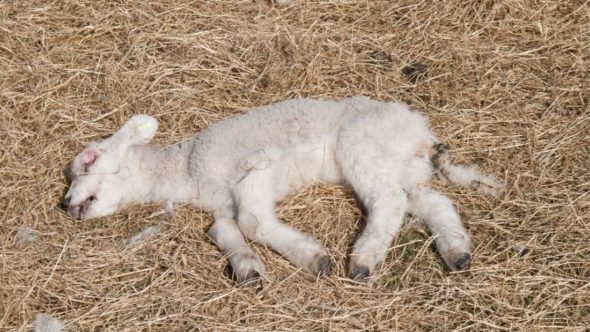
Most lambs in the UK are sent to slaughter at around six months, even though they could live up to 12 years old – that’s just one twenty-fourth of their natural life expectancy. 10 Coe S et al. 2024. Future of sheep farming. House of Commons Library. Available at: https://researchbriefings.files.parliament.uk/documents/CDP-2024-0114/CDP-2024-0114.pdf [Accessed 25 March 2025] Ewes and lambs form close bonds with one another and so when lambs are separated from their mothers to be sold for slaughter, it is a traumatic event for both. Lambs are transported in lorries, often for several hours, to be sold at auctions, sometimes several times in different parts of the country, before being slaughtered in abattoirs. Once they are over a week old, there are no extra restrictions on travel distances/times for lambs compared to adult sheep. 11 Red Tractor. 2025. Beef & Lamb Standards. Red Tractor Standards Manual. Available at: https://redtractorassurance.org.uk/wp-content/uploads/2025/01/Beef-Lamb-Standards-Feb-2025.pdf [Accessed 25 March 2025] Lamb meat is the biggest and most profitable sector of the sheep industry.
Lambs who are not slaughtered for meat may be kept on for wool or to become part of the breeding stock. Ewes are typically made to give birth every year. They are shorn once, and sometimes twice, a year, which can be painful and extremely traumatic. Now that wool is no longer as profitable as it once was, it is lambs which drive the sheep trade so once a ewe’s fertility falls, she is sent to slaughter and her meat sold as mutton.
With sheep dotted around the countryside, it’s all too easy to imagine their lives are natural, even peaceful. This bucolic image disguises the suffering that is inherent in sheep farming.
Wool

Unlike wild sheep, domesticated sheep no longer moult naturally and their fleeces are mechanically shorn at least once a year. Shearers are paid on a piece rate – by the number of sheep they shear. There is every incentive for them to rush through the process, which increases the chance of cuts and injury.
Sheep are easily frightened and don’t like being handled but shearers forcibly restrain them to remove their wool. It is traumatic for them, and they have so mistreatment is common. Shearers should be trained but there is no legal requirement, and so sheep may well be shorn by inexperienced people with all that might entail. 12 Defra. 2023. Code of recommendations for the welfare of livestock: sheep. Available at: https://www.gov.uk/government/publications/code-of-recommendations-for-the-welfare-of-livestock-sheep/sheep-and-goats-welfare-recommendations#management [Accessed 25 March 2025]
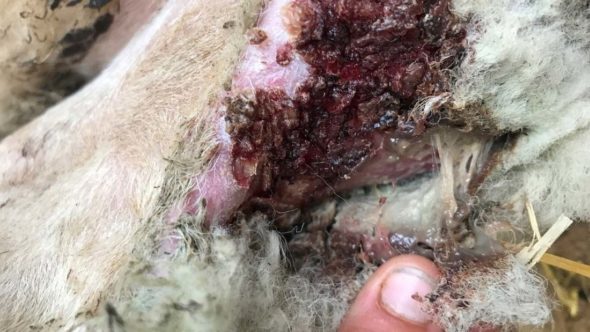
A sheep’s wounds after shearing.
Some farmers are shearing twice a year now, once in summer and again in winter when demand increases because of the cold. Winter shearing means that sheep have little or no protection against freezing temperatures and exposure, which increases rates of disease, illness, suffering and mortality – all so that the farmer can make more money.
Disease and Illness
Lameness is a major issue for the health and welfare of sheep farmed in the UK, causing significant pain to the animal. 13 National Animal Disease Information Service (NADIS). 2019. Lameness control in sheep. Available at: https://nadis.org.uk/disease-a-z/sheep/lameness-control-in-sheep/ [Accessed 25 March 2025]. Naturally an upland species, lowlands provide a frequently wet and unnatural environment for sheep and results in foot rot and high rates of lameness. You frequently see sheep grazing on their knees, a sure sign that their feet are too painful to stand on. The higher stocking densities also play a part but whatever the reason, lameness is an indication of poor management. 14 Clark B et al. 2024. Exploring farmer and advisor lameness management behaviours using the COM-B model of behaviour change. Frontiers in Veterinary Science. 17, 11, 1258906. Lameness is such a problem that it costs the UK sheep industry about £28 million a year, with three million sheep lame at any one time. 13 National Animal Disease Information Service (NADIS). 2019. Lameness control in sheep. Available at: https://nadis.org.uk/disease-a-z/sheep/lameness-control-in-sheep/ [Accessed 25 March 2025]. It’s clear that free range is not all it seems and involves widespread mismanagement and highly unsuitable environments.
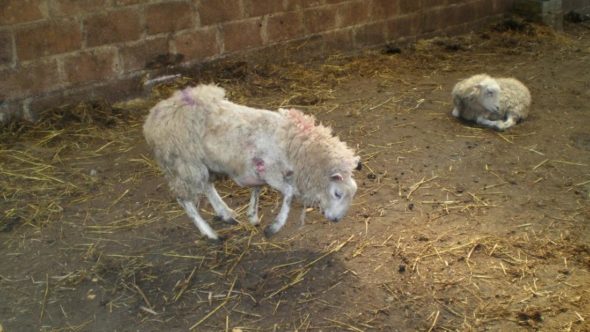
Foot rot is a cause of lameness, resulting from a dual infection by the bacteria Dichelobacter nodosus and Fusobacterium necrophorum. It’s an incredibly painful disease which is so severe that it can result in the complete loss of hooves. 13 National Animal Disease Information Service (NADIS). 2019. Lameness control in sheep. Available at: https://nadis.org.uk/disease-a-z/sheep/lameness-control-in-sheep/ [Accessed 25 March 2025]. Sheep, particularly lambs, are also susceptible to scald, which inflames the skin between the cleft of the hoof. Housing sheep indoors is not a viable, kinder alternative, as they are still at risk of foot rot from warm, damp bedding, which is a highly unnatural environment and would prevent sheep fulfilling their natural instincts.
Soil balling causes lumps of mud to tear the skin between the claws of a sheep’s hooves and makes the animal more vulnerable to scald and occurs in muddy conditions or poorly bedded buildings. Farmed sheep are susceptible to a range of other diseases, such as abscesses and granuloma, a painful condition of red growing tissue usually resulting from a too severe cutting of the hooves and which may never heal entirely. Shelly hooves occur when the sole separates from the rest of the hoof; it is often a result of poor nutrition and can result in the loss of the entire hoof. Then there are external and internal parasites such as flystrike, worms and liver fluke. Flystrike is when the soiled area around the anus becomes infected with fly maggots that burrow into the flesh.
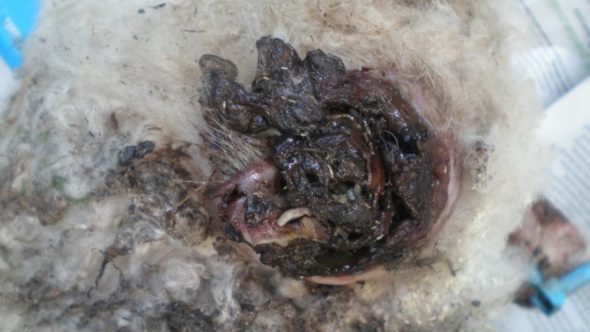
One way in which farmers deal with flystrike in Australia is by ‘mulesing’, which is the cutting away of skin around the sheep’s tail and it’s done without painkillers. While it isn’t normally done in the UK, buying merino wool supports the Australian wool industry and its cruel practices. Here in the UK, it is tail docking that is done to avert flystrike but both practices can cause long-lasting pain.
Culling
Breeding ewes are periodically culled, usually because of reduced fertility, needing assistance in giving birth or being slow to suckle lambs. They are transported to slaughterhouses, killed and their meat sold as mutton. A reduction in their wool production can also precipitate slaughter. The average age for a ewe to be culled is around three to six years old, while her natural life expectancy is 12 years.
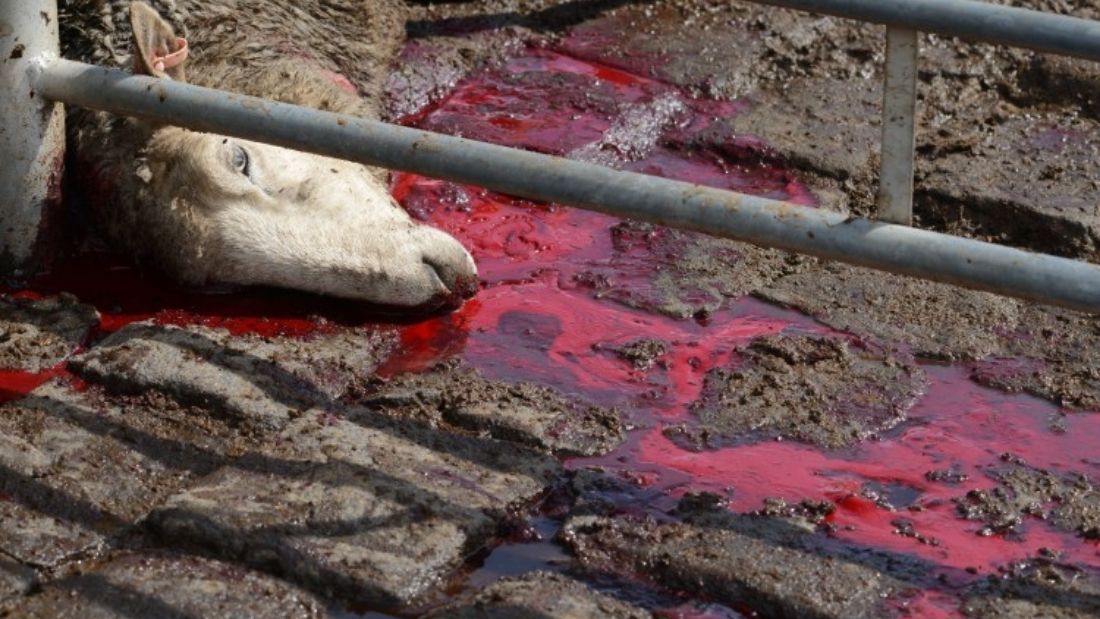
Photo credit: Jo-Anne McArthur at We Animals

Like most animals at slaughter, sheep are supposedly pre-stunned before being killed. The most common method by far is electrical stunning, where a slaughterman places electrodes on either side of the animal’s head with a device like a large pair of tongs.1Department for Environment, Food And Rural Affairs, 2019. ‘Results of the 2018 FSA Survey into Slaughter Methods in England and Wales.’ February. Available at https://assets.publishing.service.gov.uk/government/uploads/system/uploads/attachment_data/file/778588/slaughter-method-survey-2018.pdf [Accessed 9 April 2020]. Its effectiveness depends on where the electrodes are placed on the head and how long they’re applied – and it can fail on both counts.
The other method used is a penetrative captive bolt that is shot into the skull of a sheep to make him or her instantly unconscious.2Department for Environment, Food And Rural Affairs, 2015. ‘Red Meat Slaughterhouses: Restraining, Stunning, Killing Animals.’ 15 October. Available at https://www.gov.uk/guidance/red-meat-slaughterhouses-restraining-stunning-killing-animals#animal-stunning-and-killing [Accessed 9 April 2020]. The animal is then shackled by a hind leg and hoisted up onto an overhead rail where the slaughter worker ‘sticks’ it –slices its throat open and the sheep bleeds to death.2Department for Environment, Food And Rural Affairs, 2015. ‘Red Meat Slaughterhouses: Restraining, Stunning, Killing Animals.’ 15 October. Available at https://www.gov.uk/guidance/red-meat-slaughterhouses-restraining-stunning-killing-animals#animal-stunning-and-killing [Accessed 9 April 2020].
With electrical stunning, sheep can regain consciousness before being knifed. With sloppy stunning they may not lose consciousness at all but go to their death paralysed but fully aware. With captive bolt stunning, everything depends upon the accuracy of the shot and when the slaughterer has to have more than one attempt, it causes extraordinary suffering.
Even when stunning works, the whole process leading up to it can be terrifying for the animals. In large abattoirs, sheep are typically herded into the stunning area in single file by mechanical means. In small abattoirs, groups of sheep are stunned in pens. They hear the noise and smell the fear of other sheep in the slaughterhouse as they are herded one by one into the restrainer conveyor, or they see the sheep around them being stunned before it’s their turn. It is a barbaric and traumatic experience.
Slaughter without stunning causes even more suffering to the sheep. 25 per cent of sheep are killed without any stunning, with the vast majority being slaughtered in this way for Halal certification.1Department for Environment, Food And Rural Affairs, 2019. ‘Results of the 2018 FSA Survey into Slaughter Methods in England and Wales.’ February. Available at https://assets.publishing.service.gov.uk/government/uploads/system/uploads/attachment_data/file/778588/slaughter-method-survey-2018.pdf [Accessed 9 April 2020].
The carcasses of some animals killed without stunning are subsequently rejected by their faiths and are sold on the open market, so it is likely that many British consumers unknowingly eat animal products which have come from non-stunned animals.3Dalton, J., 2019. ‘Shoppers Unknowingly Buying No-stun Religious Meat in Supermarkets’. The Independent, 19 February. Available at https://www.independent.co.uk/news/uk/home-news/meat-animals-no-stun-halal-meat-supermarkets-religion-kosher-food-ban-standards-agency-a8786541.html [Accessed 25 March 2020]. There is no requirement to label their origins.




